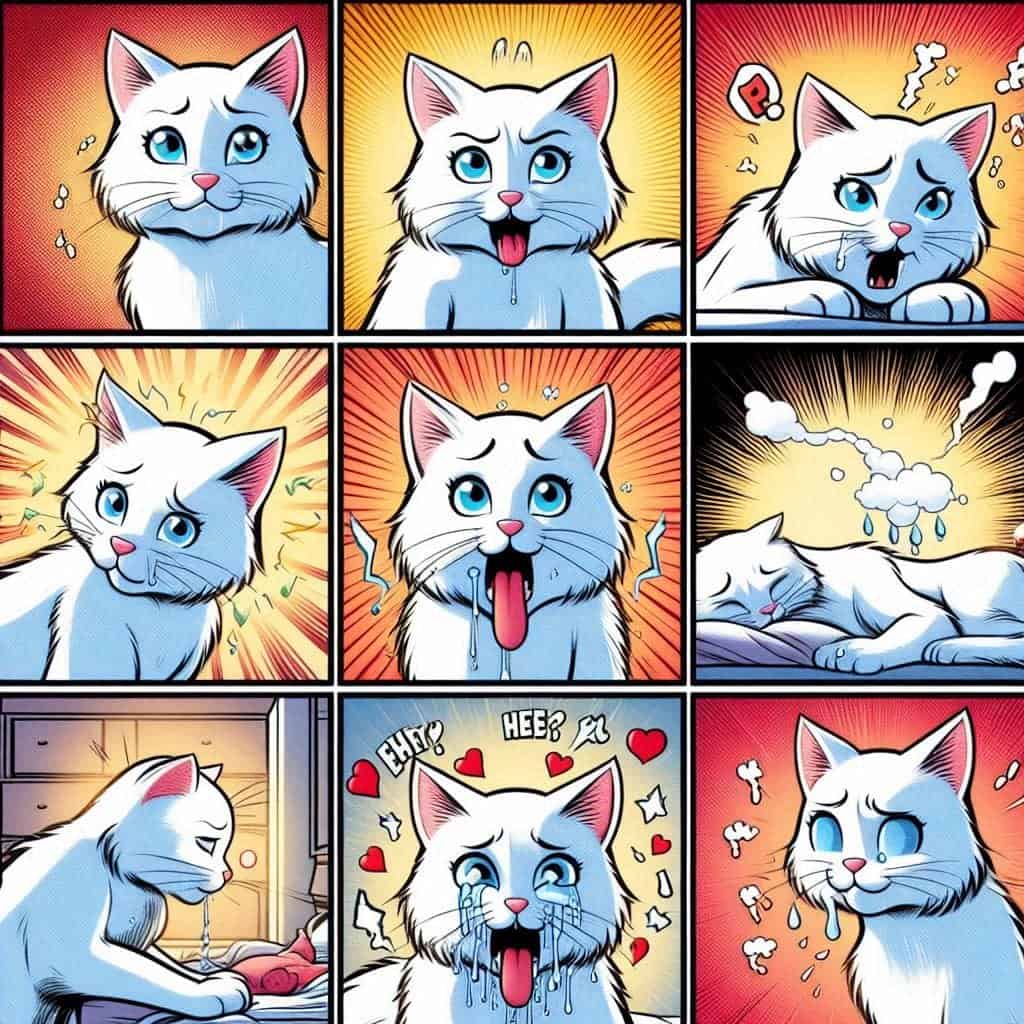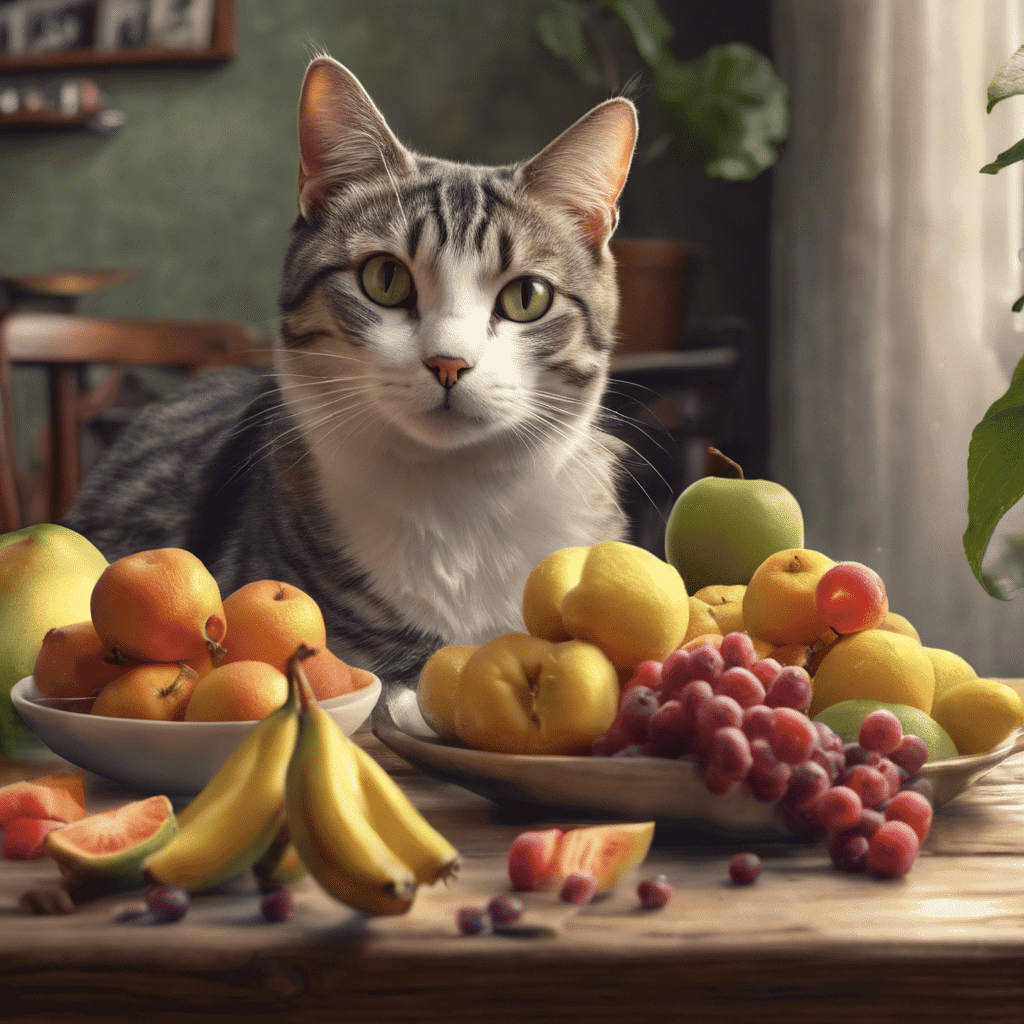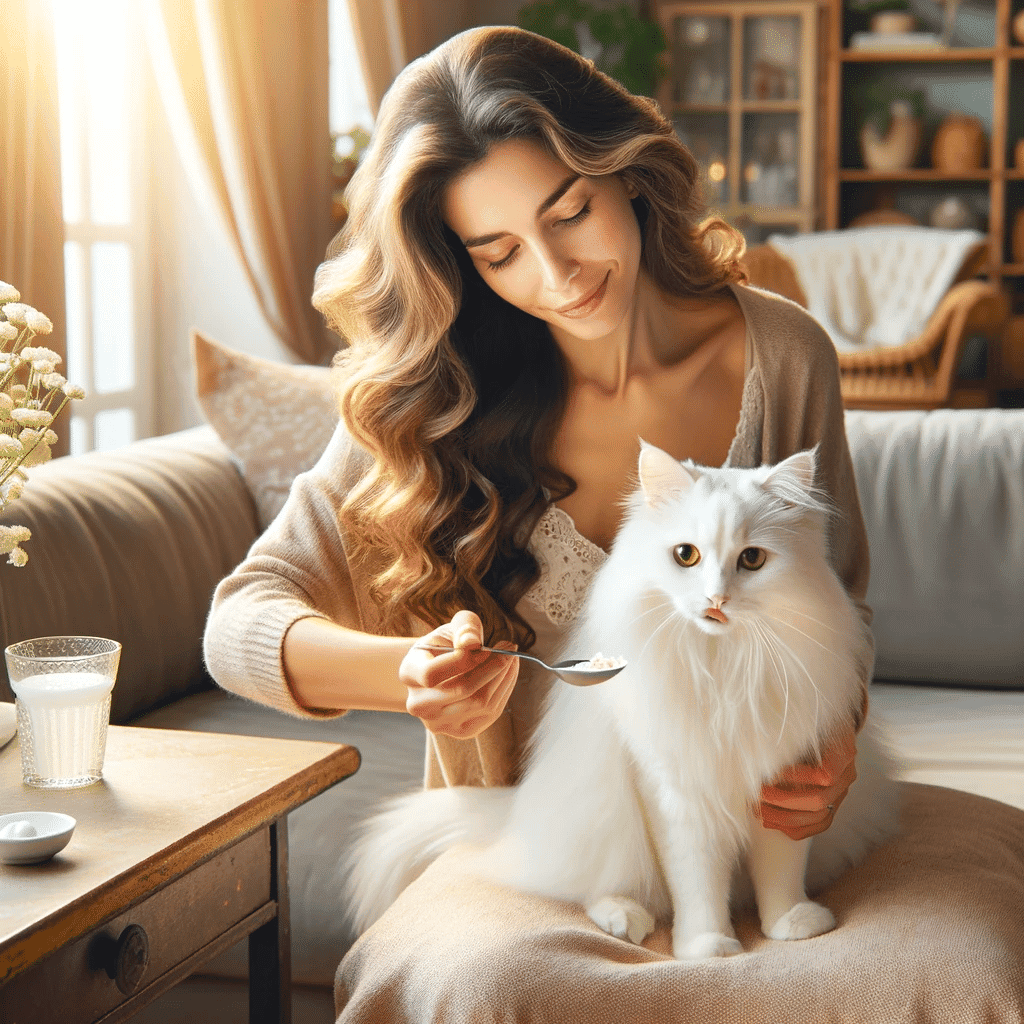When a cat is in heat, it means she is in the fertile phase of her reproductive cycle and ready to mate. This natural behavior, known as estrus, signals her body preparing for potential pregnancy. Typically, cats experience their first heat cycle around six months of age, although it can vary based on breed and individual development.
Knowing about your cat’s heat cycle is really important for any cat owner. During this period, you’ll see big changes in how your cat acts and looks. Spotting these signs can help you take better care of her.
Key Takeaway
Taking care of cats in heat is important for their health and can help stop unwanted behaviors and problems. Remember, if you’re not planning to breed your cat, spaying her is the most effective way to prevent heat cycles altogether. It not only eliminates the risk of unwanted pregnancies but also reduces the chances of certain reproductive diseases.
However, if you do decide to let your cat go through her heat cycle naturally, it’s important to keep her indoors and away from intact males to prevent mating. Providing plenty of toys and engaging activities can help distract her during this period.
You may also want to consult with your veterinarian for further advice on managing your cat’s heat cycle effectively and responsibly.
Common Signs of a Cat in Heat:
| Symptom | Description |
|---|---|
| Increased vocalization | Cats in heat tend to meow, yowl, or call out more frequently and loudly. This behavior is a way of attracting male cats and can sometimes be mistaken for a sign of distress or pain. |
| Restlessness and pacing | A cat in heat often exhibits signs of restlessness, such as pacing back and forth. They may appear unable to settle down and constantly move around the house, often looking for a way to escape and find a mate. |
| Affectionate or demanding behavior | During heat, cats may become unusually affectionate, rubbing against people and objects more than usual. They might also demand more attention from their owners, constantly seeking to be petted or held. |
| Marking territory with urine | Female cats in heat may begin to spray urine around the house to mark their territory. This behavior is driven by hormonal changes and serves to signal their availability to male cats. The urine may have a stronger odor than usual. |
These behaviors can sometimes be challenging to handle but knowing what to expect makes it easier to provide the necessary care and comfort.
By equipping yourself with knowledge about the cat heat cycle, you take an essential step toward ensuring your furry friend’s overall well-being.

The Stages of the Cat Heat Cycle
Understanding the cat heat cycle, or estrous cycle, is essential for any cat owner. This cycle determines when your cat, also known as a “queen” during this period, is fertile and ready to mate. Below is a list of all the various stages:
Proestrus
Proestrus marks the beginning of the heat cycle. During this stage:
- Duration: Typically lasts 1-2 days.
- Behavioral Changes: You might notice increased affection and vocalization.
- Physical Signs: Swelling of the vulva can occur, though it’s often subtle and easily missed.
Estrus
Estrus, or “heat,” is when your queen is most fertile. This stage includes:
- Duration: Lasts between 3 to 21 days, averaging about a week.
- Behavioral Changes: Expect heightened vocalization, restlessness, rolling on the floor, and increased affection towards humans and other animals.
- Physical Signs: More pronounced vulva swelling and possible light bleeding.
Interestrus
Interestrus occurs if ovulation does not happen during estrus. In this stage:
- Duration: Generally lasts between 1 to 2 weeks.
- Behavioral Changes: The queen’s behavior returns to normal as she temporarily exits the heat cycle.
Metestrus (or Diestrus)
Metestrus follows ovulation if mating has occurred. Key points in this stage are:
- Duration: Lasts approximately 30 to 40 days.
- Behavioral Changes: The queen shows less interest in mating.
- Physical Signs: Hormonal changes prepare her body for potential pregnancy.
Anestrus
Anestrus is the resting phase between active heat cycles. During this time:
- Duration: Typically spans from late autumn to early spring in cats not exposed to artificial lighting.
- Behavioral Changes: The queen shows no signs of being in heat.
- Physical Signs: No reproductive activity occurs during this period.
Frequency of Heat Cycles
Cats are known as polyestrous animals, meaning they can go into heat multiple times throughout the year. On average:
- Cats can enter their first heat at around six months old.
- Heat cycles can recur every two to three weeks during the breeding season (spring and summer).
Understanding these stages helps manage your cat’s behavior and health more effectively. Keeping an eye on these cycles ensures you’re prepared for each phase your feline friend goes through.
How Long Does Estrus Last in Cats?
Each estrus or heat cycle in cats generally lasts several days, with the average length being about seven days. However, it can range from 3 to 21 days. If a female cat is not mated during estrus, she will go out of heat for a short period of time, typically about seven days.
The complete estrous cycle of a cat can range from one to six weeks, with the average cycle length being about three weeks.
It’s important to note that the length of the estrus cycle can vary among individual cats and can be affected by factors such as age, health, and environment. Some cats may have shorter or longer heat cycles than the average duration. Therefore, it’s crucial for owners to closely observe their cats’ behaviors and consult with a veterinarian if they have any concerns.
During the estrus cycle, female cats may display behavioral changes such as increased vocalization, restlessness, rolling on the floor, and raising their rear quarters when petted along the back. Additionally, they may exhibit a heightened interest in male cats, increased urine marking, and a more affectionate demeanor towards their owners. These signs indicate that the cat is in heat and actively seeking a mate.
Recognizing Signs of a Cat in Heat
When your feline friend enters her heat cycle, recognizing the signs can be crucial for her well-being and your peace of mind. Understanding these signals can help manage the situation more effectively.
Behavioral Changes in Cats in Heat
Cats exhibit a range of behavioral changes when they are in heat. These behaviors can sometimes be mistaken for illness or distress, so it’s important to identify them correctly.
- Increased Vocalization: One of the most noticeable signs is excessive meowing or yowling. Your cat may become louder and more persistent in her vocalizations, often sounding like she’s in distress.
- Affectionate Behavior: Expect an increase in affectionate behavior. Your cat might rub against furniture, walls, or even you more frequently than usual.
- Restlessness: Cats in heat often display restlessness. They may pace around the house, looking for an escape route or showing an unusual interest in doors and windows.
- Rolling and Stretching: You might notice your cat rolling on the ground and stretching frequently. This is a common behavior during the heat cycle.
Physical Changes During Heat
In addition to behavioral changes, there are several physical signs that indicate your cat is in heat.
- Elevated Tail Position: When petted, a cat in heat may raise her tail to one side, a posture known as “lordosis”. This posture is a clear indicator that she is ready to mate.
- Swollen Vulva: You may observe a slight swelling of the vulva. It’s not always easy to notice but can be a subtle clue.
- Frequent Urination: Marking territory by frequent urination is another sign. Sometimes cats will spray urine around the house to signal their reproductive status.
Linking it Together
Understanding these signs helps you take appropriate measures to keep your cat comfortable and safe. For instance:
- Recognizing excessive vocalization can lead you to create a quieter environment or use calming products.
- Increased affection might prompt you to spend more time with her, providing comfort through play and interaction.
Identifying these signs not only helps manage your cat’s heat cycle but also ensures she remains healthy and happy throughout this period.
Managing Your Cat During Her Heat Cycle: 8 Effective Strategies
1. Spaying as a Long-term Solution
Managing cats during their heat cycle can be challenging, but one of the most effective and long-term solutions is spaying. This surgical procedure not only prevents your cat from experiencing future heat cycles but also offers numerous health benefits. Spayed cats are less likely to develop certain cancers, such as ovarian and uterine tumors, and they are at lower risk for infections like pyometra. By eliminating the hormonal fluctuations associated with heat cycles, spaying can reduce or completely eliminate behaviors such as yowling, marking territory, and restlessness.
Different Spaying Options
When considering spaying for your cat, it’s important to know that there are several options available:
- Traditional Spay: The most common method involves removing the ovaries and uterus through a small incision in the abdomen. This is typically performed when the cat is around six months old but can be done at any age.
- Laparoscopic Spay: A minimally invasive technique where small incisions allow the use of a camera and specialized instruments to remove the ovaries. This option offers quicker recovery times and less post-operative discomfort.
- Ovariectomy: Only the ovaries are removed, leaving the uterus intact. This procedure may be considered if there are specific health concerns that make it a preferable option.
Consulting with your veterinarian will help determine which method is best suited for your feline friend.
2. Keeping Cats Indoors: A Must-do During Heat Cycles
When it comes to managing cats during their heat cycle, preventing accidental mating is crucial. Keeping your cat indoors is one of the most effective strategies to ensure she remains safe and avoids unwanted behaviors.
Importance of Keeping Your Cat Indoors During Her Heat Cycle
Cats in heat are driven by strong instincts to find a mate. Allowing them outside significantly increases the risk of unplanned pregnancies and potential health risks. Indoor confinement not only prevents mating attempts but also curtails exposure to outdoor hazards such as traffic, predators, and infectious diseases.
Strategies for Preventing Access to Male Cats
- Secure Windows and Doors: Ensure that windows and doors are securely closed or fitted with screens to prevent your cat from escaping.
- Create a Safe Space: Designate a quiet, comfortable room where your cat can retreat during her heat cycle. Make this space appealing with cozy bedding, toys, and litter box access.
- Use Pheromone Diffusers: Products like Feliway can help reduce stress and calm your cat, making indoor confinement more manageable.
- Engage in Playtime: Regular interactive play can distract your cat from her discomfort and reduce her urge to escape.
Keeping your feline friend indoors might seem challenging at first, but with these strategies, you can create a safe haven that minimizes stress for both of you.
The focus remains on ensuring your cat’s safety and well-being during her heat cycle while maintaining harmony in your home.
3. Providing Comfort and Distractions During Heat Cycles
Managing cats during heat cycles can be challenging, but creating a soothing environment can help ease their discomfort and prevent unwanted behaviors. Here are some effective strategies to consider:
Creating a Soothing Environment
- Warm Blankets: Cats in heat often seek warmth and comfort. Providing warm blankets or heating pads can help soothe their discomfort.
- Cozy Hiding Spots: Cats feel secure when they have a quiet, cozy spot to retreat to. Set up a small, enclosed area with soft bedding where your cat can relax undisturbed.
Engaging with Toys and Interactive Playtime
Keeping your cat engaged with toys and interactive playtime can distract her from the discomfort of being in heat. Some options include:
- Puzzle Toys: These toys challenge your cat’s mind and keep her occupied for hours.
- Interactive Laser Pointers: A great way to engage your cat in physical activity while also providing mental stimulation.
- Feather Wands and Catnip Toys: Simple yet effective ways to divert your cat’s attention.
4. Using Calming Products to Ease Anxiety During Heat Cycles
Managing cats during their heat cycle can be challenging, but synthetic pheromone diffusers like Feliway offer a comforting solution. These devices emit pheromones that mimic the natural ones cats produce, creating a sense of calm and security. By placing these plug-ins around your home, you can help reduce your cat’s anxiety and minimize unwanted behaviors.
Other calming products can also play a significant role in easing your cat’s discomfort:
- Herbal Sprays: These sprays often contain ingredients like chamomile and lavender, known for their calming properties. Spritzing them in areas where your cat spends most of her time can help soothe her nerves.
- Calming Collars: Infused with relaxing scents, these collars provide continuous comfort by releasing pheromones or herbal essences throughout the day.
When considering these options, always ensure the products are safe and vet-approved to avoid any adverse reactions. For more detailed advice on dealing with stress-induced behaviors like overgrooming, check out our cat overgrooming treatment options.
Creating an environment filled with soothing elements is crucial during this period. Whether through synthetic pheromones or natural remedies, helping your feline friend remain calm will make managing her heat cycle much smoother for both of you. If you’re looking into maintaining other aspects of your cat’s health, such as dental care without toothpaste, you might find useful tips in our guide on brushing your cat’s teeth.
5. Maintaining Cleanliness: Caring for Cats in Heat
Managing cats during their heat cycle can be a challenge, but maintaining cleanliness can make a significant difference. One critical aspect is keeping the litter box clean. A spotless litter box discourages marking behaviors, which are common during this period.
Why Cleanliness Matters
Cats are naturally clean animals, and a dirty litter box can lead to unwanted behaviors like urinating outside the box. Regular cleaning ensures your cat feels comfortable using her litter box, reducing stress and potential messes.
Tips for Litter Box Maintenance:
- Scoop the litter box at least twice daily.
- Replace the litter entirely once a week.
- Use unscented, clumping litter for easy cleaning.
In addition to maintaining a clean litter box, consider these extra hygiene tips:
Using Puppy Pads or Washable Blankets
Puppy pads are excellent for managing any accidents outside the litter box. Place them in areas where your cat frequently visits. Washable blankets or covers on furniture can also help manage potential messes and are easy to clean.
Additional Hygiene Tips:
- Place washable blankets in your cat’s favorite spots.
- Use pet-safe wipes to clean any accidental messes quickly.
- Consider using an enzymatic cleaner for deep cleaning and odor removal.
Keeping your home clean not only helps manage your cat’s discomfort but also reduces stress for both you and your feline friend. If you’re interested in more cat care tips, check out our guide on how to clean cat ears without solution.
6. Consulting with a Veterinarian: When to Seek Professional Help During Heat Cycles
Recognizing when it’s time to seek professional help is a key part of managing cats during their heat cycle. Certain symptoms can indicate that your cat’s discomfort goes beyond the usual behaviors associated with being in heat.
Severe or Prolonged Symptoms
If your cat exhibits severe or prolonged symptoms, such as excessive yowling, signs of distress, or behavioral changes, it’s crucial to consult with a veterinarian. These symptoms might suggest underlying issues that require medical attention.
- Excessive Yowling: While vocalization is common during heat, incessant and loud yowling might indicate severe discomfort or pain.
- Signs of Distress: Look out for changes in eating habits, lethargy, or unusual aggression. These could signal health concerns that go beyond the normal heat cycle.
Hormone Therapy Options
For some cat owners, spaying may not be an immediate option. In such cases, discussing hormone therapy with your vet can provide temporary relief for your cat. This approach helps manage the hormonal fluctuations that cause discomfort during the heat cycle.
- Temporary Solutions: Hormone injections or oral medications can help alleviate some of the behavioral symptoms and physical discomfort associated with being in heat.
- Veterinarian Guidance: Always seek veterinary advice before starting any hormone therapy to ensure it’s appropriate and safe for your cat.
Incorporating these strategies into your management plan can make a significant difference in your cat’s well-being during her heat cycle.
Understanding when to seek professional help complements other management techniques like keeping your cat indoors or using calming products. Each strategy plays a role in ensuring your cat remains comfortable and happy throughout her heat cycle.
Health Risks Associated with Cats Being in Heat: What You Need to Know
Understanding the health risks associated with cats in heat is crucial for any responsible cat owner. These risks can sometimes be severe, making it essential to monitor your feline friend’s health closely during her estrus cycles.
Potential Health Risks
1. Pyometra
This is a life-threatening infection of the uterus that can occur if your cat goes through multiple heat cycles without mating. Symptoms include lethargy, loss of appetite, and a swollen abdomen. Immediate veterinary attention is required.
2. Ovarian Tumors
Although rare, ovarian tumors can develop in cats that are not spayed. These tumors may cause hormonal imbalances leading to irregular heat cycles and other health complications.
Monitoring Your Cat’s Health
Keeping a close eye on your cat’s behavior and physical condition during her heat cycle is vital. Look out for signs such as:
- Excessive yowling
- Discomfort or distress
- Unusual marking behaviors
- Changes in appetite or energy levels
If you notice any symptoms that seem off, it’s always best to consult with your veterinarian. They can provide guidance on whether your cat’s symptoms are part of a normal heat cycle or indicative of a more serious issue like pyometra or ovarian tumors.
Ensuring your cat receives prompt veterinary care when needed can prevent minor issues from escalating into serious health concerns. Always prioritize her well-being by staying informed and proactive during these natural cycles.
FAQs (Frequently Asked Questions)
What does it mean for a cat to be in heat?
When a cat is in heat, it refers to her reproductive cycle during which she is fertile and can mate. Understanding this natural behavior is crucial for managing your cat’s well-being and preventing unwanted behaviors and health issues.
What are common signs that a cat is in heat?
Common signs of a cat in heat include increased vocalization, restlessness, affectionate behavior towards humans or objects, and physical signs such as raised hindquarters or a more pronounced grooming behavior.
How can I manage my cat during her heat cycle?
Effective strategies for managing your cat during her heat cycle include spaying as a long-term solution, keeping her indoors to prevent mating attempts, providing comfort through cozy environments and distractions, using calming products like pheromone diffusers, maintaining cleanliness around the litter box, and consulting with a veterinarian if symptoms are severe.
What health risks are associated with cats being in heat?
During the estrus cycle, cats may face potential health risks such as pyometra or ovarian tumors. It’s important to monitor your cat’s health closely during this time and seek veterinary attention if you notice any concerning symptoms.
Why is spaying recommended for female cats?
Spaying is recommended as it prevents future heats and associated behaviors. It also eliminates the risk of certain health issues related to the reproductive system and contributes to better overall behavior in female cats.
Helpful Reads
- https://www.kingsdale.com/how-often-do-cats-go-into-heat-the-essential-facts
- https://vcahospitals.com/know-your-pet/estrus-cycles-in-cats
- https://cats.com/do-cats-go-through-puberty

In her previous life, Lisa traveled extensively, both for work and leisure. After the pandemic struck, Lisa locked up her luggage and adopted a cat ever since.
Lisa is now an avid cat lover, she devotes most of her free time serving as butler to her adorable feline at home. When she is not with her cat, she can be seen using her phone sourcing for the latest cat supplies online.


